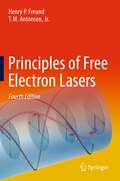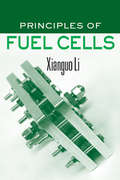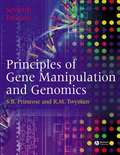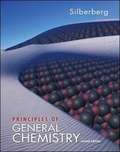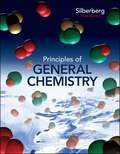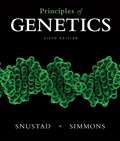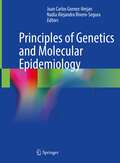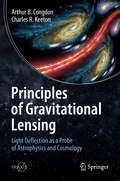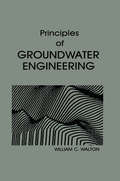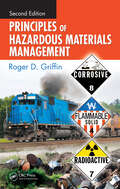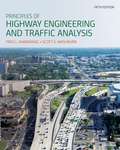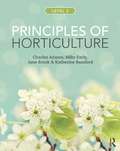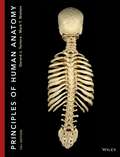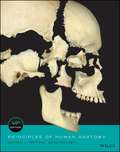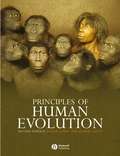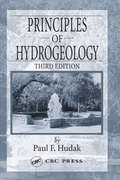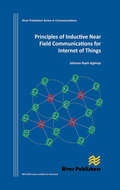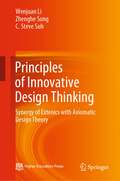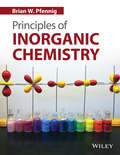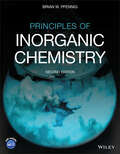- Table View
- List View
Principles of Free Electron Lasers
by Henry P. Freund T.M. Antonsen, Jr.This book presents a comprehensive description of the physics of free-electron lasers starting from the fundamentals and proceeding through detailed derivations of the equations describing electron trajectories, and spontaneous and stimulated emission. Linear and nonlinear analyses are described, as are detailed explanations of the nonlinear simulation of a variety of configurations including amplifiers, oscillators, self-amplified spontaneous emission, high-gain harmonic generation, and optical klystrons. Theory and simulation are anchored using comprehensive comparisons with a wide variety of experiments.
Principles of Fuel Cells
by Xianguo LiThe book is engineering oriented and covers a large variety of topics ranging from fundamental principles to performance evaluation and applications. It is written systematically and completely on the subject with a summary of state-of-the-art fuel cell technology, filling the need for a timely resource. This is a unique book serving academic researchers, engineers, as well as people working in the fuel cell industry. It is also of substantial interest to students, engineers, and scientists in mechanical engineering, chemistry and chemical engineering, electrochemistry, materials science and engineering, power generation and propulsion systems, and automobile engineering.
Principles of Gene Manipulation and Genomics
by Richard Twyman Sandy B. PrimroseThe increasing integration between gene manipulation and genomics is embraced in this new book, Principles of Gene Manipulation and Genomics, which brings together for the first time the subjects covered by the best-selling books Principles of Gene Manipulation and Principles of Genome Analysis & Genomics. Comprehensively revised, updated and rewritten to encompass within one volume, basic and advanced gene manipulation techniques, genome analysis, genomics, transcriptomics, proteomics and metabolomics Includes two new chapters on the applications of genomics An accompanying website - www.blackwellpublishing.com/primrose - provides instructional materials for both student and lecturer use, including multiple choice questions, related websites, and all the artwork in a downloadable format. An essential reference for upper level undergraduate and graduate students of genetics, genomics, molecular biology and recombinant DNA technology.
Principles of General Chemistry (Second Edition)
by Martin S. SilberbergSilberberg’s Principles of General Chemistry offers students the same authoritative topic coverage as its parent text, Chemistry: The Molecular Nature of Matter and Change. The Principles text allows for succinct coverage of content with minimal emphasis on pedagogic learning aids. This more straightforward approach to learning appeals to today’s efficiency-minded, value-conscious instructors and students without sacrificing depth, clarity, or rigor.
Principles of General Chemistry (Third Edition)
by Martin S. SilberbergSilberberg's Principles of General Chemistry offers students the same authoritative topic coverage as its parent text, Chemistry: The Molecular Nature of Matter and Change. The Principles text allows for succinct coverage of content with minimal emphasis on pedagogic learning aids. This more streamlined approach to learning appeals to today's efficiency-minded, value-conscious instructors and students without sacrificing depth, clarity, or rigor.
Principles of Genetics (Sixth Edition)
by D. Peter Snustad Michael J. SimmonsSnustad's 6th edition of Principles of Genetics offers many new and advanced features including boxed sections with the latest advances in Genetics, a streamlined roster of topics, a more reader-friendly layout, and new problem-solving supplements. Furthermore, this new edition includes more problem solving within each chapter through the Test Your Problem Solving Skills feature and a Solve It icon to prompt readers to go online to WileyPlus for animated tutorials. A new one-column design better showcases important pieces of art and avoids the "overwhelmed" reaction readers have to the crowded layouts found in many other texts. Boxed sections reduce in size to help maintain the flow of the text and the Focus On boxes are revised to include the most current developments in genetics as well as most relevant topics.
Principles of Genetics and Molecular Epidemiology
by Juan Carlos Gomez-Verjan Nadia Alejandra Rivero-SeguraThis book covers some of the most novel genetic and genomic concepts in epidemiology, such as geospatial statistics and systems biology from a clinical point of view by explaining molecular applications with accessible human studies. Featuring a comprehensive table of contents, it includes chapters from genomics and epidemiology surveillance to transcriptomics and alternative splicing principles.Across 17 well-organized chapters, this book meets attempt to explain easily to clinicians and students with basic principles of the genetics, genomics, molecular biology and its applications to epidemiology and public health. The text is distinct from other literature on the market because it covers useful genomic tools applied in epidemiology for clinicians who may not be experts in this branch of health science. Principles of Genetics and Molecular Epidemiology demystifies the idea that biomedicine is far from being applied in both epidemiology and clinical practice.
Principles of Geoarchaeology: A North American Perspective
by Michael R. WatersPresents the basics of geoarchaeology, through application of field techniques to a study of the late Quaternary of America. Alluvial, terrestrial and coastal environments are considered, as well as post burial physical disturbances of archaeological sites.
Principles of Geology
by Charles LyellOne of the key works in the nineteenth-century battle between science and Scripture, Charles Lyell's Principles of Geology (1830-33) sought to explain the geological state of the modern Earth by considering the long-term effects of observable natural phenomena. Written with clarity and a dazzling intellectual passion, it is both a seminal work of modern geology and a compelling precursor to Darwinism, exploring the evidence for radical changes in climate and geography across the ages and speculating on the progressive development of life. A profound influence on Darwin, Principles of Geology also captured the imagination of contemporaries such as Melville, Emerson, Tennyson and George Eliot, transforming science with its depiction of the powerful forces that shape the natural world.
Principles of Gravitational Lensing: Light Deflection as a Probe of Astrophysics and Cosmology (Springer Praxis Books)
by Arthur B. Congdon Charles R. KeetonThis textbook provides an introduction to gravitational lensing, which has become an invaluable tool in modern astrophysics, with applications that range from finding planets orbiting distant stars to understanding how dark matter and dark energy conspired to form the cosmic structures we see today. Principles of Gravitational Lensing begins with Einstein’s prediction that gravity bends light, and shows how that fundamental idea has spawned a rich field of study over the past century.The gravitational deflection of light was first detected by Eddington during a solar eclipse in May 1919, launching Einstein and his theory of relativity into public view. Yet the possibility of using the phenomenon to unlock mysteries of the Universe seemed remote, given the technology of the day. Theoretical work was carried out sporadically over the next six decades, but only with the discovery of the system Q0957+561 in 1979 was gravitational lensing transformed from a curiosity of general relativity into a practical observational tool.This book describes how the three subfields known as strong lensing, weak lensing, and microlensing have grown independently but become increasingly intertwined. Drawing on their research experience, Congdon and Keeton begin with the basic physics of light bending, then present the mathematical foundations of gravitational lensing, building up to current research topics in a clear and systematic way. Relevant background material from physics and mathematics is included, making the book self-contained.The derivations and explanations are supplemented by exercises designed to help students master the theoretical concepts as well as the methods that drive current research. An extensive bibliography guides those wishing to delve more deeply into particular areas of interest. Principles of Gravitational Lensing is ideal for advanced students and seasoned researchers looking to penetrate this thriving subject and even contribute research of their own.
Principles of Groundwater Engineering
by William C. WaltonThe purpose of this book is to bring together under one cover the principles of groundwater engineering. The concise format has produced a handy, comprehensive manual for professionals working in the groundwater industry. The author places emphasis on the application of theory and practical aspects of groundwater engineering. Well-cited references throughout the text guide you through the technology, scientific principles, and theoretical background of groundwater engineering. Exhaustive appendices contain quantitative data necessary for in-groundwater flow and contaminant migration equations. Principles of Groundwater Engineering is the state-of-the-art book that bridges the gap between groundwater theory and groundwater problem solving.
Principles of Hazardous Materials Management
by Roger D. GriffinSince the publication of the first edition of this volume in 1988, we have made great strides in reducing the amount of toxic waste that threatens our water, soil, and air. A greater acceptance of clean fuels and clean technologies, along with increased public awareness of environmental health hazards has given us greater optimism about the future
Principles of Highway Engineering and Traffic Analysis (5th Edition)
by Fred L. Mannering Scott S. WashburnThe 5th edition of the Mannering's Principles of Highway Engineering and Traffic Analysis continues to offer a concise approach that covers all the necessary fundamental concepts. New features in this edition include updates and more consistency with the latest edition of the Highway Capacity Manual (HCM); the inclusion of sample FE exam questions, call-out of common mistakes; and added coverage on a qualitative description of the mechanistic approach.
Principles of Horticultural Physiology
by Edward DurnerUnderstanding the physiology of plants is fundamental to horticultural studies and practice. Aimed at undergraduates, this major textbook covers applied aspects of physiology related to horticultural crops. The author discusses specific physiological processes in relation to horticultural management, maintaining a focus throughout on how horticultural practices influence plant productivity and quality. Principles of Horticultural Physiology begins by guiding students through the basics of plant physiology; plant anatomy and plant classification, before covering plant hormones, growth and development, and factors related to the external environment including water, light, temperature and soil. Greenhouse culture is also discussed, as well as practical management techniques including seeding, pruning and grafting. The book concludes with real-world horticultural considerations of harvesting crops, packaging and transportation, postharvest physiology and marketing plant products, as well as a fascinating chapter on plants and human nutrition. One of the text's chief virtues is the accessible way the author conveys sometimes complex information in an easy to follow style. An ideal resource for undergraduate students of horticulture, this book will act as a guide throughout the entire course.
Principles of Horticulture
by Charles Adams Jane Brook David Francis Mike EarlyGardening and horticulture generally are essentially practical activities much enhanced by an understanding of how plants grow. This colourful guide will introduce you to the fundamentals of horticulture. It is written in a clear and accessible style and covers the principles that underpin growing plants for the garden and allotment, with reference to how these are tackled by professionals.With highlighted definitions, key points and illustrations in full colour, this book will be a useful companion as you progress in the study and practice of horticulture. The book covers topics such as classifying and naming plants, the plant life cycle, ecology and garden wildlife, soils, composts, hydroponics, weeds, plant nutrition, plant pests, and plant diseases and disorders. The new edition has been updated to reflect changes in legislation and the modernization of horticultural practices. It is also fully reflective of the changes in the new syllabuses for horticulture at Level 2.Principles of Horticulture is a valuable resource whether you are taking a Level 2 RHS, City and Guilds, Teagasc or SNQ course, or are a keen amateur or seasoned gardener.The book is accompanied by ancillary materials including essential and extended information on horticultural principles and downloadable instructor resources.
Principles of Horticulture: Level 2
by Charles Adams Mike Early Jane Brook Katherine BamfordThis colourful guide will introduce you to the fundamentals of horticulture, whether you are taking a Level 2 RHS, City and Guilds or BTEC course, are a keen amateur or seasoned gardener. Written in a clear and accessible style, this book covers the principles that underpin growing plants for the garden and on the allotment, with reference to how these are tackled by professionals. With highlighted definitions, key points, and illustrated in full colour, this book will be a useful companion as you progress in the study and practice of horticulture. Complete with a companion website which includes extended horticultural information, questions and exercises to test your knowledge, syllabus cross-referencing and downloadable tutor and student support materials. Available at www.routledge.com/cw/adams
Principles of Human Anatomy
by Gerard J. Tortora Mark T. NielsenA market-leading text through its many editions, the 13th edition of Principles of Human Anatomy continues to successfully blend visual and textual elements to illuminate the complexities of human anatomy. Written for the 1-term human anatomy course, the 13th edition raises the standard for excellence in this discipline with its enhanced illustration program, refined narrative, and the integrated design of dynamic resources like Real Anatomy 2. 0 into the curriculum.
Principles of Human Anatomy
by Gerard J. Tortora; Mark T. NielsenImmerse yourself in the spectacular visuals and dynamic content of Principles of Human Anatomy, 14th Edition. Designed for the 1-term Human Anatomy course, this 14th edition raises the standard for excellence in this discipline with its enhanced illustration program, refined narrative, and dynamic resources. Principles of Human Anatomy is a rich digital experience, giving students the ability to learn and explore human anatomy both inside and outside of the classroom.
Principles of Human Evolution: A Core Textbook
by Roger Lewin Robert Andrew FoleyPrinciples of Human Evolution presents an in-depth introduction to paleoanthropology and the study of human evolution. Focusing on the fundamentals of evolutionary theory and how these apply to ecological, molecular genetic, paleontological and archeological approaches to important questions in the field, this timely textbook will help students gain a perspective on human evolution in the context of modern biological thinking. The second edition of this successful text features the addition of Robert Foley, a leading researcher in Human Evolutionary Studies, to the writing team. Strong emphasis on evolutionary theory, ecology and behavior and scores of new examples reflect the latest evolutionary theories and recent archaeological finds. More than a simple update, the new edition is organized by issue rather than chronology, integrating behavior, adaptation and anatomy. A new design and new figure references make this edition more accessible for students and instructors. New author, Robert Foley – leading figure in Human Evolutionary Studies – joins the writing team. Dedicated website – www.blackwellpublishing.com/lewin – provides study resources and artwork downloadable for Powerpoint presentations. Beyond the Facts boxes – explore key scientific debates in greater depth. Margin Comments – indicate the key points in each section. Key Questions – review and test students’ knowledge of central chapter concepts and help focus the way a student approaches reading the text. New emphasis on ecological and behavioral evolution – in keeping with modern research. Fully up to date with recent fossil finds and interpretations; integration of genetic and paleoanthropological approaches.
Principles of Hydrogeology
by Paul F. HudakPrinciples of Hydrogeology, Third Edition presents important concepts of groundwater hydrology with a strong emphasis on problem-solving and field applications of hydrogeology. With newly added and revised content, this volume maintains a broad and current scope of topics, from the history of hydrogeology to the latest trends in managing groundwate
Principles of Igneous and Metamorphic Petrology (Second Edition)
by John D. WinterThis text is designed for use in advanced undergraduate or early graduate courses in igneous and metamorphic petrology. The book is extensive enough to be used in separate igneous and metamorphic courses, but I use it for a one-semester combined course by selecting from the available chapters. The nature of geological investigations has largely shaped the approach that I follow.
Principles of Inductive Near Field Communications for Internet of Things
by Johnson I. AgbinyaNear field communication devices and the emerging field of Internet of things require efficient short range communication techniques. Classical telecommunication theory however has so far focused on radiating electromagnetic signals which is more suited to terrestrial communication systems. Over the last decade however considerable research and applications of inductive methods have emerged as innovative approaches for secure short range communications by changing the paradigm of an established model of electromagnetic communications. We have witnessed the emergence of embedded inductive medical devices, magneto-inductive waveguides, inductive pots and cooking devices, magneto-inductive sensors, wireless power transfer, inductive hearing aids and the emerging inductive point-to-point communication specifically termed near-field communication (NFC) as used in mobile phones and payment cards to name a few. While there exist a large set of distributed methods and algorithms detailing the design and performances of such applications, a significant gap is observed as a lack of detailed collection of the methods in one place which could be easily understood and used quickly by someone seeking to apply the methods.In this book this missing gap is filled with the required details and the theory of near field communication systems including both the radiating and reactive (energy coupling) near-field systems in addition to the well known far field radiation techniques. The book details the fundamental expressions and design methods which facilitate the creation of near field devices and equipment including embedded biomedical implants. The book contains recent advances in inductive communications, performance, limitations and a collection of applications. It also lays a strong foundation for the application of inductive methods for creating Internet of Things systems.
Principles of Innovative Design Thinking: Synergy of Extenics with Axiomatic Design Theory
by C. Steve Suh Zhenghe Song Wenjuan LiThe book presents a comprehensive treatment on a novel design theory that fosters innovative thinking and creativity essential for addressing wicked problems. Wicked problems are ill-defined, ambiguous in both aims and solutions, and complex with interconnected and intertwined (coupled) factors. While being ubiquitous and difficult, however, wicked problems share characteristics common to science and design in three regards, namely agent finitude, system complexity, and problem normativity. These fundamental attributes allow a core cognitive process common to design and science to be identified and a strategic problem-solving conception of methodology be formulated as a result. The theory facilitates new opportunities for synergetic cross-disciplinary research and practice by incorporating the essences of Extenics to axiomatic design. Innovative thinking is enabled by exploring Extenics for problem reframing, paradigm shift, and abductive reasoning and by engaging axiomatic design in the co-evolution (iteration) of the need and viable design concept. The theory is unique in that it is a framework for quantifying imprecise and vague design information available during the conceptual design stage as mathematical expression and algorithm early in the design effort and enables the objective evaluation and emergence of an optimal design concept from among multitude of viable ones. The book is conceived for students and real-world practitioners in engineering, natural and social sciences, business, and fine arts who seek to develop powerful design thinking for solving problems in a creative and innovative way.
Principles of Inorganic Chemistry
by Brian W. PfennigAimed at senior undergraduates and first-year graduate students, this book offers a principles-based approach to inorganic chemistry that, unlike other texts, uses chemical applications of group theory and molecular orbital theory throughout as an underlying framework. This highly physical approach allows students to derive the greatest benefit of topics such as molecular orbital acid-base theory, band theory of solids, and inorganic photochemistry, to name a few. Takes a principles-based, group and molecular orbital theory approach to inorganic chemistry The first inorganic chemistry textbook to provide a thorough treatment of group theory, a topic usually relegated to only one or two chapters of texts, giving it only a cursory overview Covers atomic and molecular term symbols, symmetry coordinates in vibrational spectroscopy using the projection operator method, polyatomic MO theory, band theory, and Tanabe-Sugano diagrams Includes a heavy dose of group theory in the primary inorganic textbook, most of the pedagogical benefits of integration and reinforcement of this material in the treatment of other topics, such as frontier MO acid--base theory, band theory of solids, inorganic photochemistry, the Jahn-Teller effect, and Wade's rules are fully realized Very physical in nature compare to other textbooks in the field, taking the time to go through mathematical derivations and to compare and contrast different theories of bonding in order to allow for a more rigorous treatment of their application to molecular structure, bonding, and spectroscopy Informal and engaging writing style; worked examples throughout the text; unanswered problems in every chapter; contains a generous use of informative, colorful illustrations
Principles of Inorganic Chemistry
by Brian W. PfennigPRINCIPLES OF INORGANIC CHEMISTRY Discover the foundational principles of inorganic chemistry with this intuitively organized new edition of a celebrated textbook In the newly revised Second Edition of Principles of Inorganic Chemistry, experienced researcher and chemist Dr. Brian W. Pfennig delivers an accessible and engaging exploration of inorganic chemistry perfect for sophomore-level students. This redesigned book retains all of the rigor of the first edition but reorganizes it to assist readers with learning and retention. In-depth boxed sections include original mathematical derivations for more advanced students, while topics like atomic and molecular term symbols, symmetry coordinates in vibrational spectroscopy, polyatomic MO theory, band theory, and Tanabe-Sugano diagrams are all covered. Readers will find many worked examples throughout the text, as well as numerous unanswered problems at varying levels of difficulty. Informative, colorful illustrations also help to highlight and explain the concepts discussed within. The new edition includes an increased emphasis on the comparison of the strengths and weaknesses of different chemical models, the interconnectedness of valence bond theory and molecular orbital theory, as well as a more thorough discussion of the atoms in molecules topological model. Readers will also find: A thorough introduction to and treatment of group theory, with an emphasis on its applications to chemical bonding and spectroscopy A comprehensive exploration of chemical bonding that compares and contrasts the traditional classification of ionic, covalent, and metallic bonding In-depth examinations of atomic and molecular orbitals and a nuanced discussion of the interrelationship between VBT, MOT, and band theory A section on the relationship between a molecule’s structure and bonding and its chemical reactivity With its in-depth boxed discussions, this textbook is also ideal for senior undergraduate and first-year graduate students in inorganic chemistry, Principles of Inorganic Chemistry is a must-have resource for anyone seeking a principles-based approach with theoretical depth. Furthermore, it will be useful for students of physical chemistry, materials science, and chemical physics.
